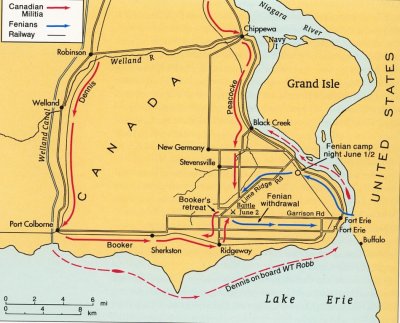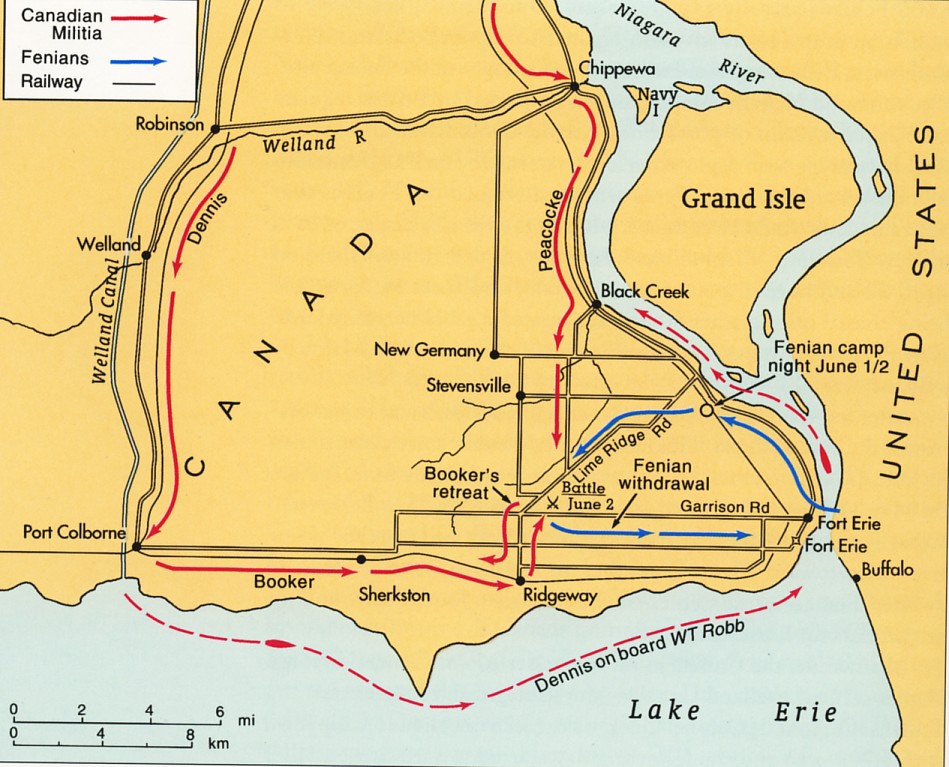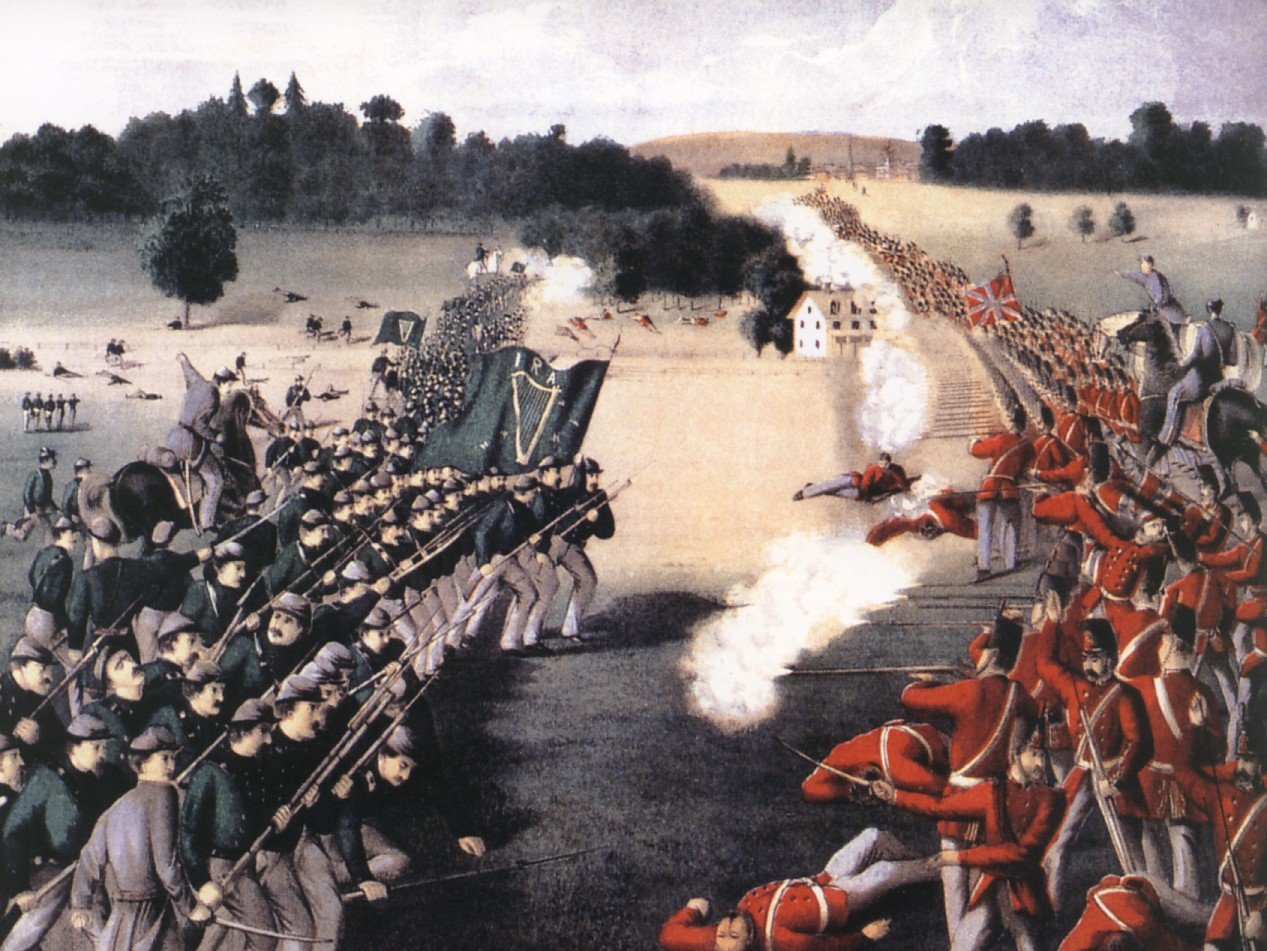
foreword | Historical Narratives | Resources | Links | Contact
THE BATTLE OF RIDGEWAY
History is a pattern of timeless moments.
For weeks towns along the border with the United States had buzzed with wild rumours and false alarms about an imminent invasion of Canada by the Fenians. Fiery speeches in Buffalo by Fenians had fanned feelings of hatred toward the English occupiers of "dear ould Ireland." For its refusal to grant Ireland independence, Britain was going to pay and pay dearly.
The Fenian Brotherhood was formed in Ireland in 1858. Its objective was to liberate Ireland from its British connection and establish the Republic of Ireland. An American branch of the Brotherhood was formed in the United States and its leader, an unstable demagogue named John O'Mahony [*] decided to conquer and Canada [**] and hold her hostage. The price demanded for her return: a liberated Emerald Isle. It was a crazy scheme to be sure, but the Fenians felt they could accomplish it and they heralded their hardihood in this 1866 Fenian battle song.
 |
|
Fenian John O'Mahony |
"We are the Fenian brotherhood, skilled in arts of war
And we're going to fight for Ireland, the land that we adore.
Many battles have we won, along with the boys in blue,
And we'll go and capture Canada, for we've nothing else to do."
At the end of the American Civil War nearly a million men suddenly found themselves unemployed. Among those hardest hit were thousands of Irish-Americans, some of whom decided to put their military might to good use by liberating Mother Ireland from its English occupiers. Where better to hit and hurt Britain than in its nearby colony, Canada. The city of Buffalo swarmed with fire-breathing Fenians simply waiting for the word to act. Arms and supplies from the demobilizing Union Army had been bought and shipped north to depots along the Canadian border.
Meanwhile, across the narrow Niagara River Canadians watched, wondered and worried. On May 31 Premier John A. Macdonald had called out the Canadian militia. The Queen's Own Rifles of Toronto in their hot winter uniforms of green entrained and were sent to Port Colborne some eighteen miles west of Fort Erie. At Hamilton the 13th Battalion clothed in scarlet was called up and a force of regulars was assembled at St. Catharines. The units marched and counter-marched with nervous enthusiasm and feelings of loyalty they had not felt since being menaced by the Americans in 1812 and 1838.
While the American government took no part in the Fenian foray they did nothing to stop it. Their inactivity in the face of this force about to cross into Canada reflected American hostility towards Canada because of Britain's support for the South in the Civil War.
 |
|
|
At dawn on Friday, June 1st, 1866 it happened. Sleepy-eyed residents of Fort Erie awakened to the sound and sight of strangers in their midst flying a foreign flag. It was the flag of the Fenians: a gold harp and crown on a field of green.
 |
|
|
Under the forbearing gaze of American authorities, some thousand members of the Brotherhood had crossed the river and scrambled ashore unopposed at what today is the intersection of Bowen Avenue and the Niagara Parkway. They were, they proudly proclaimed to the locals, men whose mission was to rid the residents of Canada from "British tyranny." They had brought extra arms and uniforms for the flood of new recruits they expected to jump at the chance to join in the liberation of their country. When no Canadians responded to this crazy call to arms the Fenians were astounded and perplexed by these passive people.
The Fenian leader, Lieutenant-Colonel John O`Neill, demanded and received food for his hungry heroes and following their meal of bread, ham and coffee provided gratis by the locals, the tired troops stretched out in the shade to take a nap. Their laid-back military manner seemed to suggest this was more of a picnic than an armed invasion. After a restful siesta O'Neill left a small force at Fort Erie and set out with the remaining Fenians along the river road for the confrontation to come for he knew two military columns were headed in their direction.
The Fenians proceeded north along the Parkway past Frenchmen's Creek where they paused, peered about and pondered what lay ahead. It was their intention to keep Black Creek between them and the approaching British force which was led by Lieutenant-Colonel John J. Peacocke. In the vicinity of Townline Road the Fenians turned west where they camped for the night on June 1st. Early the next morning they were on they moved along Black Creek, then Beaver Creek thence southwest on Ridge Road to a strong position on the high ground not far from Ridgeway at a point called Limestone Ridge.
The Canadian troops numbering some 400 detrained at Ridgeway. They included volunteer militia of the Queen's Own Rifles, the 13th Battalion and the Caledonian and York Rifle Companies. The soldiers were chiefly young men with little training, no battle experience and led by an equally inexperienced and very nervous commander, Lieutenant Colonel Alfred Booker. At 7:30 a.m. on June 2nd, 1866 a clear, sunny, summer day the young soldiers moved off without breakfast up the Ridge Road, each bearing thirty-five rounds of ammunition and a rapidly beating heart. Ahead on the high ground awaited the foreign invaders. A witness to the battle to come is the neat, little, brown, brick farmhouse that after 140 years still occupies the corner of the battle site at the intersection of Hwy. 3 and Ridge Road.
 |
|
Ridgeway Battlefield |
 |
|
Battle of Ridgeway 2 June 1866 |
On a day too beautiful for battle the militia moved forward firing as they filtered through farmers' fields filled with daisies and buttercups. "The line was well formed and their advance was brave." Neither side suffered serious casualties and with ammunition depleted the Canadian front rank retired and was replaced by fresh volunteers. After a short skirmish the Fenians, fearful of being surrounded by Peacocke's force of regulars and volunteers marching menacingly towards them from the north, decided to fall back to Fort Erie.
Suddenly to the bewilderment of both sides a militia bugler sounded retreat and the Canadians began to fall back. Then when the Fenian mounted scouts were mistaken for cavalry, Booker threw his forces into confusion by ordering them to form a square. Revitalized by their enemy's perplexed plight, the Fenians pressed forward firing and drove them from the field with a bayonet charge. In the confused fighting that followed nine Canadians were killed and thirty-seven were wounded.
The following account of this action is taken from the diary of militiaman Arthur James Moodie Tenny who fought in the field that fateful day.
In His Own Words"The Queens Own Rifles of Toronto, 13th Battalion of Hamilton and two York Companies engaged about 1000 men. The Q. O. R. drive the Fenians from their position and about three miles when being out of ammunition, the 13th were ordered to relieve them. When this was done the Q.O. retired under cover. When it found out the 13th could not hold their own, the Q.O. were again ordered out. My company when passing thro an orchard heard the cry 'Prepare for cavalry'. We formed square when several were shot. The bugle then sounded the 'Retire' when returned to the reserve which had formed square to receive cavalry. Oh, that awful Square! Men falling all around us thick and fast with no chance to protect themselves. The order to reform for action was given but even the stern command of Major Gilmor and the officers could not prevent the terrible confusion which followed. When hark! What is that cry? A line of red coats is seen thro the trees some distance back. The cry is 'The 47th Regulars.' Hats fly up with loud hurrahs. Men are frantic with wild excitement and joy that the day is not lost thro their mistake. No use trying to reform! No use trying to regain command of the men. The excitement is too great, too wild to be brought under control. Many are coolly and independently firing at the Fenians, thus keeping them is check. A few start for the redcoated line, others follow. When it seems impossible to prevent it the whole body of 600 men retire to gain help from the supposed 'Regulars'. Lo! Phantom like it retreats and is lost sight of. Where is it? There is no one to answer. It was a terrible delusion. It was only the rear guard of our own brigade drawn up in line with fixed bayonets waiting the order to advance or retire. The Fenians then retreated to Fort Erie where they crossed the river at night. The fight lasted six hours. Q.O. lost 9 killed and about 40 wounded. Fenian loss is unknown."
The Fenians' picnic became a panic as they suddenly realized the sunny morning might see many of them finished in this foreign country. Fear is infectious and night saw it racing through their ranks. On reaching Fort Erie the Fenians fled across the river - some swimming, some paddling planks and some drowning. Those who reached the American shore were arrested. Later that morning when the Canadian militia arrived at Fort Erie, they found the Fenians had fled. There were no more raids on the Niagara frontier. The vigilance of the authorities and the readiness of Canadians to defend their soil forestalled any more Fenian incursions into Canada.
Canadians were grateful to those who fought and fell that day as Arthur James Moodie Tenny recorded in his diary.
In His Own Words"June 5
Q.O.R. ordered to Stratford, left on board cars at 3 am, passed Hamilton at 11 am, reached Stratford at 5 pm. Grand reception by the townspeople. My brother George and I were billeted on Mr. W. Dutton Druggist whose family treated us very kindly.
June 19
Returned to Toronto at 6 pm enthusiastically received by the whole city."
This Fenian foray into the fertile fields of Niagara has now become a tourist attraction - the Battle of Ridgeway Scenic Drive. Distinctive Battle of Ridgeway signs bearing the busts of two soldiers representing the opposing forces now mark the picturesque drive. In an hour or so it is possible to follow the fortunes and the foibles of friend and foe alike as they occurred that soft summer day one hundred and forty years ago.
The blood of the nine brave young militiamen who fell fighting the Fenians at Ridgeway was shed for a far greater cause than they knew. Fear of the Fenian threat which might very well have dragged in forces of the United States drew British North Americans together. The invasion had a very positive effect on the patriotism of the people and contributed greatly to the formation of a proud, new nation - Canada.
[*]John O'Mahony the 19th-century founder of the Fenian rebel movement and the would-be conqueror of Canada is to be honoured as a hero of Irish nationalism this month at his Dublin gravesite 140 years after his failed 1866 invasion of New Brunswick. A terrorist in the eyes of British and Canadian officials of the day, O'Mahony will be hailed at a May 28th anniversary ceremony as in "inspirational force" in the fight that - long after his death in 1877 = led to the creatin of the Republic of Ireland. In Canada O'Mahony is best remembered as a blundering rebel and an accidental Father of Confederation. [National Post, May 6, 2006] [**] Canada then comprised two provinces: Canada East (Quebec) and Canada West (Ontario). This attack took place in Canada West.Copyright © 2013 Website Administrator